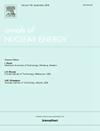Computer simulation of the processing of uranium mononitride with an argon-oxygen gas mixture
IF 1.9
3区 工程技术
Q1 NUCLEAR SCIENCE & TECHNOLOGY
引用次数: 0
Abstract
Uranium mononitride (UN) appears to be one of the most efficient fuels for nuclear reactors. The creation of a closed fuel cycle requires the reprocessing of spent nuclear fuel (SNF). The spent fuel reprocessing cycle includes the conversion of nitride fuel into actinide oxides. The oxidation of UN in an oxygen-argon environment at a temperature of 923 K was studied using the molecular dynamics method. A significant difference in the rate of oxide formation for crystalline and amorphous UN particles was revealed. The structure of these particles during the transition from nitride to uranium oxides was studied in detail based on the calculation of partial radial distribution functions and the construction of hybrid polyhedra. For a particle with an amorphous structure, the amount of U–O bonds created significantly exceeds the corresponding characteristic for a crystalline particle. This is facilitated by more intense fragmentation of the amorphous particle in the gaseous Ar–O mixture. Temperature is a more important regulator of the oxidation process than the oxygen concentration in the gas mixture. The destruction of U–N bonds leads to the formation of nitrogen gas, and when U–O bonds are formed, clusters of uranium oxides are created, tending to agglomeration.

氩氧混合气处理单氮化铀的计算机模拟
单氮化铀(UN)似乎是最有效的核反应堆燃料之一。建立一个封闭的燃料循环需要对乏核燃料进行后处理。乏燃料后处理循环包括将氮化物燃料转化为锕系氧化物。采用分子动力学方法研究了UN在923 K氧-氩环境下的氧化过程。在氧化物形成速率的显著差异,为晶体和非晶的UN粒子被揭示。通过部分径向分布函数的计算和杂化多面体的构造,详细研究了这些粒子在氮化物向铀氧化物转变过程中的结构。对于具有非晶结构的粒子,产生的U-O键的数量明显超过晶体粒子的相应特征。这是由于气态Ar-O混合物中非晶态颗粒破碎更强烈而促成的。在氧化过程中,温度是比混合气体中的氧浓度更重要的调节因素。铀-氮键的破坏导致氮气的形成,当铀-氧键形成时,形成铀氧化物簇,倾向于团聚。
本文章由计算机程序翻译,如有差异,请以英文原文为准。
求助全文
约1分钟内获得全文
求助全文
来源期刊

Annals of Nuclear Energy
工程技术-核科学技术
CiteScore
4.30
自引率
21.10%
发文量
632
审稿时长
7.3 months
期刊介绍:
Annals of Nuclear Energy provides an international medium for the communication of original research, ideas and developments in all areas of the field of nuclear energy science and technology. Its scope embraces nuclear fuel reserves, fuel cycles and cost, materials, processing, system and component technology (fission only), design and optimization, direct conversion of nuclear energy sources, environmental control, reactor physics, heat transfer and fluid dynamics, structural analysis, fuel management, future developments, nuclear fuel and safety, nuclear aerosol, neutron physics, computer technology (both software and hardware), risk assessment, radioactive waste disposal and reactor thermal hydraulics. Papers submitted to Annals need to demonstrate a clear link to nuclear power generation/nuclear engineering. Papers which deal with pure nuclear physics, pure health physics, imaging, or attenuation and shielding properties of concretes and various geological materials are not within the scope of the journal. Also, papers that deal with policy or economics are not within the scope of the journal.
 求助内容:
求助内容: 应助结果提醒方式:
应助结果提醒方式:


